In the nonprofit sector, uncertainty is nothing new. But the current funding landscape—with declining federal support and growing pressure on private philanthropy—has pushed many organizations to the edge of their comfort zone.
That’s why Elevate’s second session in our 2025 Conversation Series struck a chord. Titled Doing Less with Less, the virtual event on March 6, 2025 brought together leaders from across the country to face today’s biggest challenges head-on. We were joined by Elevate’s Founder and CEO, Alayna Buckner, as well as the Co-Founder and CEO of 20 Degrees, Sara Gibson. Alayna and Sara provided thoughtful and practical advice for nonprofit leaders at this moment of uncertainty.
Here are the five questions nonprofit professionals are asking most—and the practical steps you can take right now.
1. What should I be doing right now?
Let’s face it: being a nonprofit leader today means holding uncertainty in one hand and responsibility in the other.
Here’s what to focus on:
- Do an exposure assessment: Evaluate your programs and funding sources. Which initiatives or budget line items are most at risk if grants or federal dollars are cut?
- Plan for multiple futures: Think worst-case, best-case, and everything in between. Give each scenario a name (yes, really—it helps make the process easier to manage).
- Strengthen your relationships: Talk to your board, funders, elected officials, and peer orgs. Communicate early, clearly, and often.
These early steps align with the mindset we explored in this previous blog post on adapting to uncertainty, which offers additional ways to stay grounded and proactive before making major decisions.
2. How do I make decisions when the future is uncertain?
No one has a crystal ball. But that doesn’t mean you can’t plan.
Smart moves to make now:
- Clarify your criteria: Get grounded in your mission, values, community needs, and financial picture.
- Differentiate major vs. routine decisions: Don’t freeze. Some choices—like whether to backfill a role—can buy you time while you wait for more clarity on the larger, strategic decisions you’ll need to make.
- Explore your option set: Cutting costs, shifting resources, pausing programs, or pursuing mergers are all on the table.
Bonus tip: Download 20 Degrees’ Resilience Roadmap for a hands-on framework to help guide your planning process.
3. What should I do if there’s just not enough funding?
It’s a hard truth: sometimes the numbers just don’t work.
What to do when you’re facing shortfalls:
- Get clear on your tipping point: Know the exact conditions that would lead you to pause or end a program.
- Create a closure checklist: Have a plan for winding down responsibly, including how you’ll communicate with stakeholders, other organizations where you can refer clients, and the methods in which you’ll document learnings.
- Plan for a comeback: If funding comes back down the line, you’ll want to be ready to relaunch.
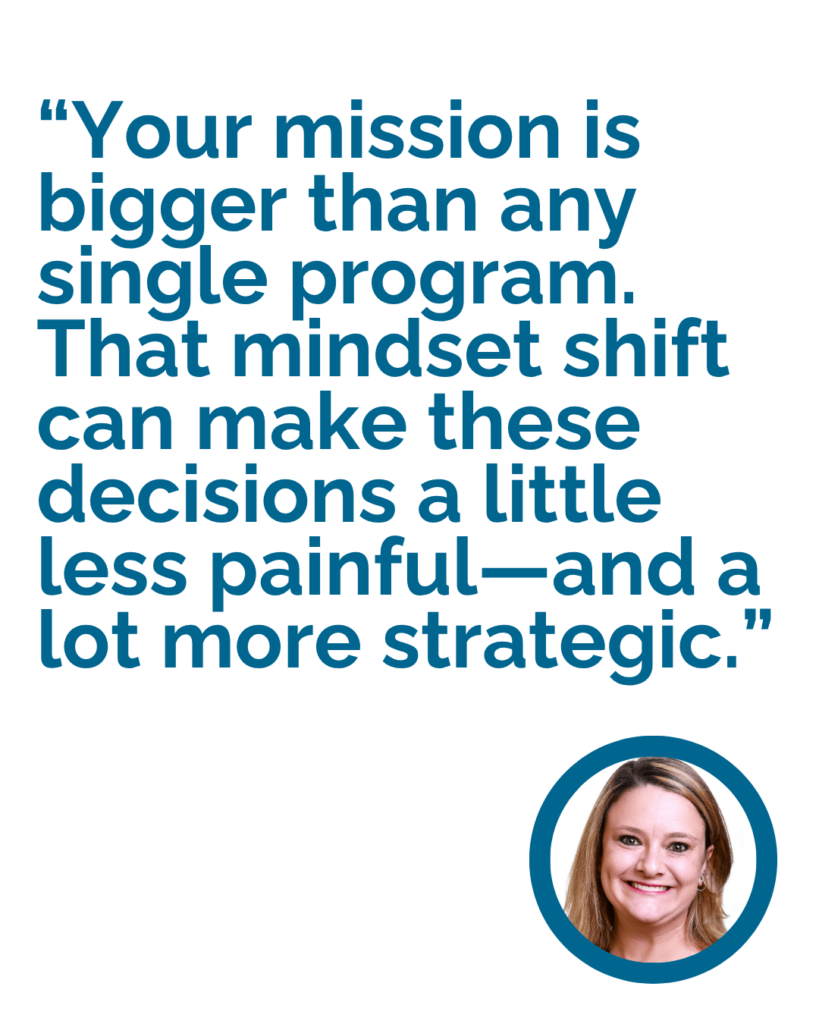 Remember: your mission is bigger than any single program. That mindset shift can make these decisions a little less painful—and a lot more strategic.
Remember: your mission is bigger than any single program. That mindset shift can make these decisions a little less painful—and a lot more strategic.
4. How do I make time for planning when I’m already swamped?
You’re juggling more than ever, and now you’re supposed to plan on top of that?
Try this:
- Honor your energy: Schedule planning time when you’re most focused—even if it’s just 20 minutes a week.
- Share the load: Involve your senior team and your finance folks. This doesn’t have to be a solo project.
- Make a “stop doing” list: What can you pause for the next 4–6 weeks to free up space for the work that matters most?
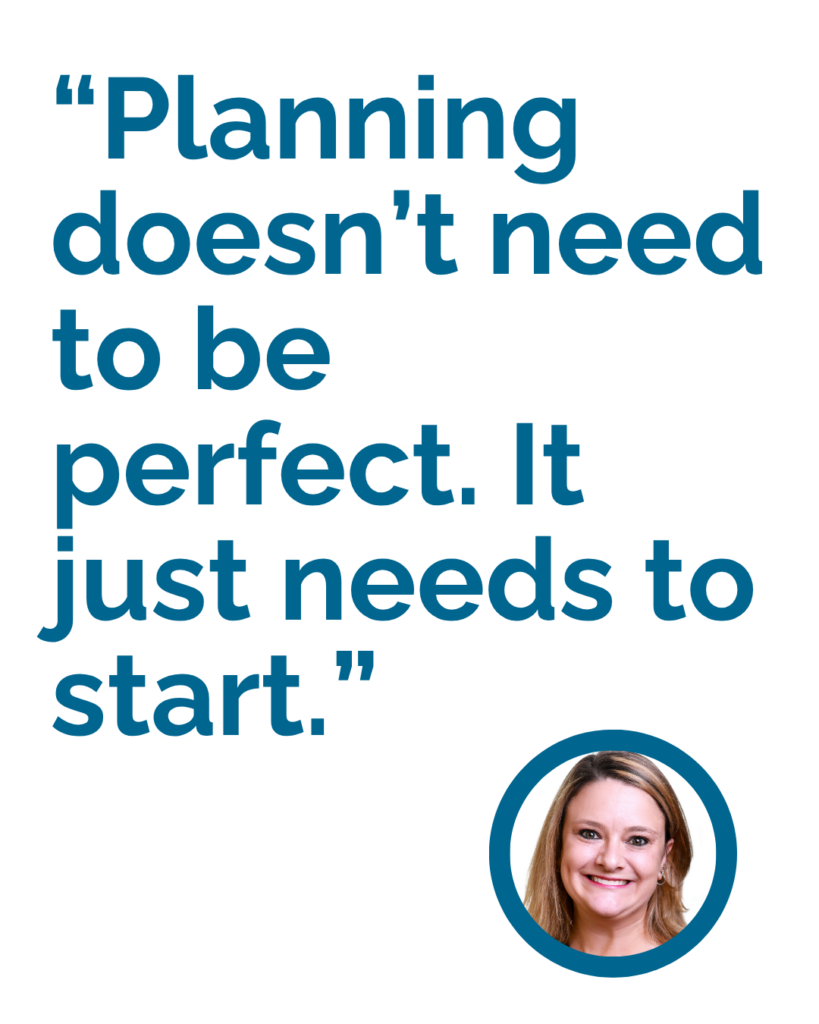 Planning doesn’t need to be perfect. It just needs to start.
Planning doesn’t need to be perfect. It just needs to start.
5. How do I get my Board more engaged right now?
When funding shifts, your board’s role becomes even more critical—but also more complex.
Tips for stronger board engagement:
- Communicate early and clearly: Avoid surprises. Consider holding a special meeting with a single-issue agenda.
- Balance realism with possibility: Share challenges, but also offer a path forward. Help them stay hopeful and informed.
- Clarify expectations: Your board probably won’t fill budget gaps—but they can help advocate, fundraise, and spread the word.
And remember: business-minded board members may need extra guidance to understand the social sector’s priorities and constraints.
Final Thoughts
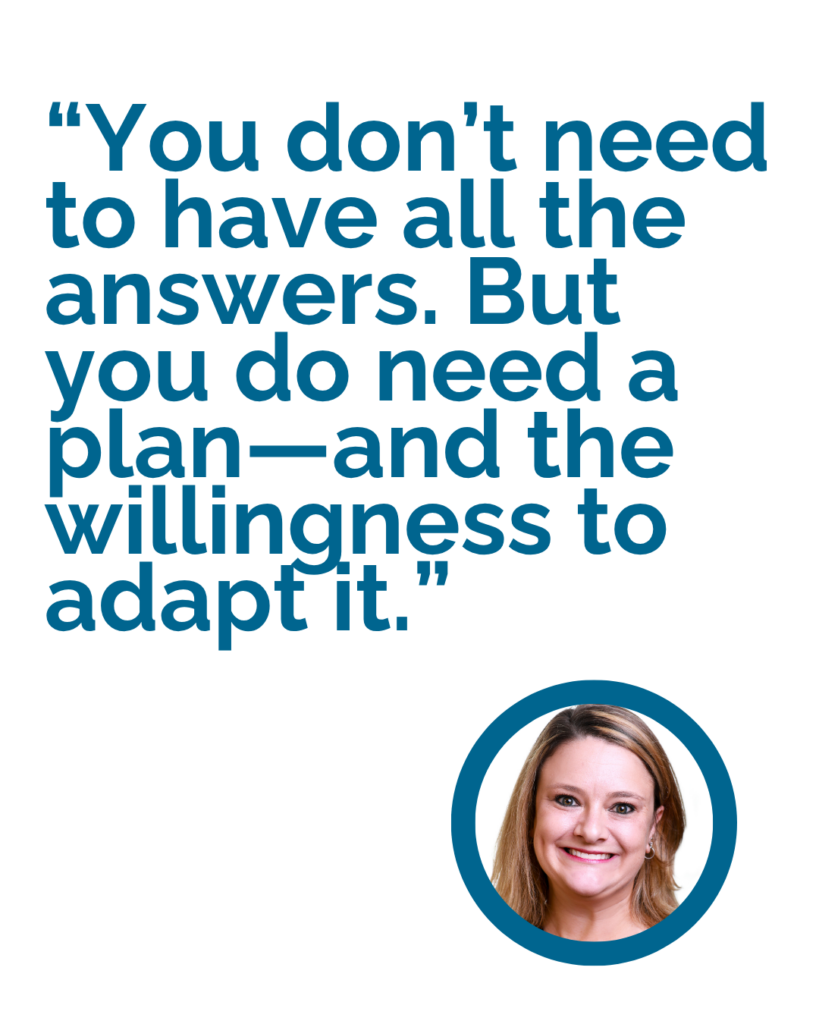 You don’t need to have all the answers. But you do need a plan—and the willingness to adapt it.
You don’t need to have all the answers. But you do need a plan—and the willingness to adapt it.
Whether you’re evaluating programs, weighing funding scenarios, or just trying to protect your team’s energy, one thing is clear: the work you’re doing matters. And you don’t have to do it alone.
Additional Resources
12 Urgent Financial Action Steps – Nonprofit Financial Commons
Strategy Triage Tool – Center for Community Investment
Checklist for Winding Down a Program – Nonprofit Risk Management Center
4 Things Nonprofits Can Do Now, to Better Adapt to Uncertainty – Elevate Blog
Resilience Roadmap – 20 Degrees
At Elevate, we know that identifying and securing grants is often the backbone of nonprofit funding strategies. We also realize that finding the right funders and crafting compelling proposals requires more than just a surface-level search—it demands strategic and comprehensive prospect research. Using multiple research tools is not just recommended; it’s essential for maximizing your grant success. Here’s why and how to do it effectively.
Why Use Multiple Prospect Research Tools?
Grantmakers often don’t reveal their full scope of funding interests on their websites. For example, a glance at the Susan Thompson Buffett Foundation’s website might lead you to believe they only offer scholarships to Nebraska students. However, digging deeper with tools like Candid’s Foundation Directory Online (FDO) or Inside Philanthropy reveals their significant contributions to reproductive health initiatives. This deeper understanding can help nonprofits determine strategic alignment and customize proposals accordingly.
Elevate’s Toolbox for Comprehensive Prospect Research
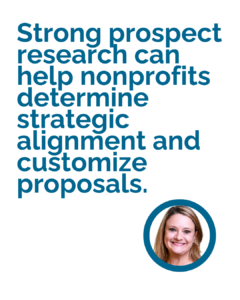 At Elevate, leveraging a mix of paid and free prospect research tools ensures high-quality outcomes for clients. Here’s a breakdown of some key tools and how they can elevate your grant-seeking efforts:
At Elevate, leveraging a mix of paid and free prospect research tools ensures high-quality outcomes for clients. Here’s a breakdown of some key tools and how they can elevate your grant-seeking efforts:
1. Salesforce (or your own donor database)
- What It Does: Tracks funder and opportunity records with comprehensive data, including email history and activity logs.
- Why It’s Unique: Elevate’s extensive internal database allows teams to analyze trends across thousands of funders. Collaboration is seamless, as team members can share insights and follow up on opportunities.
2. Candid (FDO)
- What It Does: Provides profiles on nearly 300,000 grantmakers and 2 million grant recipients, along with 990 forms, grant opportunities, and federal grant information.
- Why It’s Unique: Its LinkedIn integration and ability to export data to Excel make it a powerful tool for strategy analysis and networking.
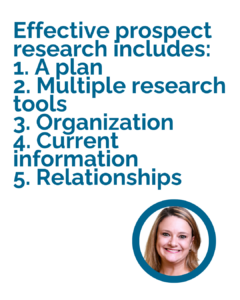 3. Inside Philanthropy
3. Inside Philanthropy
- What It Does: Features profiles of grantmaking organizations and tracks open RFPs with its GrantFinder tool.
- Why It’s Unique: Users can filter funders by issue, geography, and major donors while accessing articles on philanthropy trends.
4. Instrumentl
- What It Does: Generates comprehensive “funding landscapes” that highlight relevant funders and open opportunities in specific sectors.
- Why It’s Unique: Its “openness to new grantees” insights and high-volume prospect generation set it apart.
5. Free Tools (e.g., LinkedIn, CauseIQ, and Influence Watch)
- What They Do: Provide access to information on influencers, funders, and peer organizations. Tools like LinkedIn help build connections with program officers and grantmakers.
- Why They’re Valuable: Free resources often complement paid tools by filling in gaps or providing quick, high-level insights.
Best Practices for Effective Prospect Research
- Start with a Strategic Plan: Identify your funding priorities and narrow your search to tools and resources that align with your organization’s mission.
- Combine Tools for Deeper Insights: Cross-reference information from multiple sources to uncover hidden opportunities and verify funder alignment.
- Stay Organized: Log your findings, track communication history, and collaborate with your team.
- Stay Current: Regularly review platforms like Inside Philanthropy and the Chronicle of Philanthropy for updates on grantmaking trends.
- Engage with Funders: Use LinkedIn or email to connect with program officers, build relationships, and gain insight into funder priorities.
Conclusion
In today’s competitive funding landscape, successful grant seeking requires more than just a quick Google search. By utilizing multiple prospect research tools, nonprofits can uncover opportunities that align with their mission, craft tailored proposals, and build lasting relationships with funders. With a well-rounded approach to research, your organization can maximize its chances of securing the grants it needs to thrive.
And for more on prospecting, join us for Elevate’s popular Prospect Research: How to Find Grant Opportunities webinar.
For many nonprofits, federal grants and contracts are just one part of their larger revenue profile. With the news to date this year dominated by updates regarding reductions in federal funding, little advice is available about how policy change at the federal level contributes to changes in private funding priorities and availability.
In early 2025 Elevate hosted a three-part Conversation Series on Navigating Uncertainty in the Funding Landscape. The first of these – But what about private grants? – covered our responses to 5 questions Elevate’s nonprofit partners have asked about their private foundation grant strategy in the context of uncertainty around federal funds. (Register today for the third event in the series, Lessons from the Field, on March 27, 2025!)
This article provides highlights from the Conversation Series session, including the questions, key considerations, and Elevate’s advice for nonprofit leaders.
Question #1: If we lose public funding for our programs, can we replace it with increased support from foundations or corporations?
If your federal grants or contracts are rescinded or ended, it is unlikely that you will be able to replace that funding with private support.
 First, there is far more public funding than private funding. In 2023, the federal government provided $303 billion in grants and contracts to nonprofits, whereas private foundations award around $107 billion annually to U.S. nonprofits. It is not reasonable to expect that private philanthropy could “step up” and fill this gap.
First, there is far more public funding than private funding. In 2023, the federal government provided $303 billion in grants and contracts to nonprofits, whereas private foundations award around $107 billion annually to U.S. nonprofits. It is not reasonable to expect that private philanthropy could “step up” and fill this gap.
Instead, private philanthropy is likely to get more competitive in a period of constrained resources. We expect that more organizations will be appealing to foundations for limited private funds, and that grantmakers may opt to focus their own limited resources on supporting those organizations with whom they already have relationships.
Second, private funders are unlikely to prioritize filling the gap created by a loss of public funding. Philanthropy sees their role as distinct from the public sector. Private grantmakers are more likely to be interested in opportunities to build capacity, test new ideas, and establish the evidence for what works, whereas public funding is often leveraged to support direct programmatic services. What’s more, private funders who want to demonstrate resistance to the current administration do not want to step into this gap because it takes the pressure off of the government to play their part.
At the end of the day, there is simply no equivalency between public and private funding and one cannot build effective fundraising strategies that assume private funders will simply “step up” where public funding is declining.
Question #2: What can I do today to shore up my existing private funding streams?
We all care a lot about the work we do and the communities we work with, so it can be hard to discuss the possibility that we will have to navigate a period of fewer resources and less support for the communities we serve. So, what can nonprofit leaders do now?
 First, talk with your funding partners. Foundations and corporations rely on their grantees to tell them about community needs – it’s why nearly every grant proposal requires you to define the need you are addressing. When things are changing quickly, as they are now, grantmakers have less insight than you do about whether the need is increasing, decreasing, or just changing. Be proactive – don’t wait for your funders to ask. Reach out to make them aware of what’s happening at your organization and offer to be a resource to funders who want to be part of the conversation.
First, talk with your funding partners. Foundations and corporations rely on their grantees to tell them about community needs – it’s why nearly every grant proposal requires you to define the need you are addressing. When things are changing quickly, as they are now, grantmakers have less insight than you do about whether the need is increasing, decreasing, or just changing. Be proactive – don’t wait for your funders to ask. Reach out to make them aware of what’s happening at your organization and offer to be a resource to funders who want to be part of the conversation.
As we saw during COVID-19, the foundations and corporations who already know and trust your work are those you can go to first and most easily when the community needs are changing. Because you have already made the case to them, they already know the needs your organization addresses, and you can focus on updating them on how things are changing in the current context.
Similarly, when the future is highly uncertain, it is harder for philanthropists to invest in new grantees. Many grantmakers will opt to increase funding for their current grantees who are reaching out with requests for additional support. Others may not have the capacity to get to know new organizations and the needs they address while the foundation itself is reworking its own priorities in a period of change. Developing a new funding relationship is never easy, and it will likely be even more challenging in the current context.
Question #3: How do I talk to my funding partners about all of this?
Your donors are going to be hearing from all of their grantees – plus organizations seeking new support – during this time of uncertainty. The calls for additional support will be coming from all sides, and you’ll have to work even harder now to stand out from the crowd.
 Keep in mind that the best practices of cultivation and stewardship still apply: keep in touch with your donors, update them about your work, and offer to be a resource to them about what is happening on the ground.
Keep in mind that the best practices of cultivation and stewardship still apply: keep in touch with your donors, update them about your work, and offer to be a resource to them about what is happening on the ground.
Start by asking questions. What are foundation leaders thinking about and grappling with themselves at this time? How can you – as a community leader – help them understand the impact of the Executive Orders and other federal actions on your organization and your community? Use what you know about the funder’s history of giving, the concerns they share, and the relationship you’ve built to be explicit about how you are aligned.
Be specific about the ways your organization is being impacted. Have you lost important sources of funding? Are you concerned about possible legal actions? Are the people you serve at risk of losing rights or services? How can private funding make a real difference for the community you serve or for whom you advocate in this context?
Finally, while making the case for the need for funding, what positive news can you share about how your organization has prepared to navigate the weeks, months, and years ahead that will give your funders a sense that continued (or increased!) funding is a good investment? What leadership expertise, financial strategies, or planning do you have in place to support your organization’s ability to navigate difficult circumstances? In other words, make your request from a position of strength, rather than from a position of distress or alarm.
Question #4: Should we change how we talk about our DEI work?
The backlash against Diversity, Equity, and Inclusion efforts makes many feel unsafe, while others may feel disheartened by the clash between the discourse and their own values.
 The efforts to dismantle DEI in philanthropic and nonprofit sectors predates the recent Executive Orders. Our colleague, Johnisha Levi, published an informative and well-researched article last year highlighting the impact of the June 2023 Supreme Court decision, which found that Harvard’s “race conscious” admissions violated the Constitution. This was the beginning of a significant sea change against affirmative action and other DEI strategies that is now being amplified by the current administration.
The efforts to dismantle DEI in philanthropic and nonprofit sectors predates the recent Executive Orders. Our colleague, Johnisha Levi, published an informative and well-researched article last year highlighting the impact of the June 2023 Supreme Court decision, which found that Harvard’s “race conscious” admissions violated the Constitution. This was the beginning of a significant sea change against affirmative action and other DEI strategies that is now being amplified by the current administration.
While the anti-DEI Executive Orders are challenged in court, public and private institutions find themselves in limbo.
If you receive direct federal funding, you have likely already received instructions from the granting agency on what will need to change about how you talk about your work or about the work you actually do with your grant funds. If you receive pass-through funding, the guidance may come later as the information trickles down to sub-grantees.
While they receive these notices about their federal grants, many of our clients have asked whether they should be taking similar steps to change the language around DEI in their private grant applications.
We caution against making dramatic changes to how you talk about your work until you know more about each foundation or corporate funder’s stance. There will likely be some grantmakers that will increase their support of organizations working with immigrants, supporting the LGBTQIA+ community, or advancing race equity in their communities. Others may take a more conservative approach.
At this time, most private and corporate funders have not had a chance to change their application templates, so they will continue to ask for demographic information about the community you serve, your staff and board, and other details. You should still fill that information out as accurately as possible.
Question #5: How do I plan for the future?
The past 5 years have been a historically hard time to lead a nonprofit, and a key reason for that is the pressure that comes from knowing that people rely on the work you do to meet their basic needs, learn and grow, maintain or improve their health, access employment and opportunities that benefit their families, and more.
 Considering a future where you have fewer resources and are thus less able to do this important work can be overwhelming.
Considering a future where you have fewer resources and are thus less able to do this important work can be overwhelming.
At this point, our advice is to:
- Focus on What Matters Most: What is your unique and essential contribution to your community? This is what you prioritize over everything else.
- Phone a Friend (or Many Friends): Call that extra board meeting. Gather information from your community advisory board. Talk to your staff, beneficiaries, and partners to understand what they need, what they can offer, and how you can work together.
- Plan for Multiple Futures: Where is your funding coming from? What does your financial picture look like if one funding stream disappears? What does it look like if some but not all of your private/corporate funding continues?
And finally, join Elevate for Lessons from the Field, the third event in this Conversation Series, on Thursday, March 27, 2025. We will hear from a panel of nonprofit leaders who will share their experiences facing difficult times in the past, including policy changes, funding crises, and natural disasters. We’ll explore questions like: What can we learn from the past? How can nonprofits move forward now in a way that aligns to their missions and values? Register today!
New year, new grant services–that’s the saying right? Either way, I am very excited for the opportunity to share more information about the launch of Elevate’s newest services: the Grants Accelerator Project Suite. These projects are designed to take the strategic grant work that Elevate is known for and package it into bite size pieces that are perfect for organizations that are just getting their grant programs started. Read on to learn more about Elevate’s new offerings and how you can move forward if they sound right for you.
If you’ve been in Elevate’s orbit for a while, this name may sound familiar–for the last several years we have offered a three- or four-month Grants Accelerator Project that brought together grants strategy guidance, prospecting, and language generation. We’ve worked with dozens of organizations on these projects, helping to stand up new grant programs and set organizations on the path to grant sustainability. However, we recognized that this package wasn’t quite right for organizations that were really trying to figure out how to get started from square one, and that the bundling of multiple types of support could lead us to inadvertently miss the mark on what an organization really needed. So, in 2024 we decided to deconstruct the Grants Accelerator Project into its component parts (and add a few new projects!) to create the Grants Accelerator Project Suite!
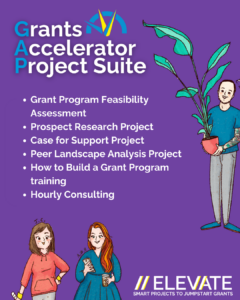 Through the new GAP Suite, we’re excited to offer a menu of project-based engagements that are cost efficient, maintain a laser focus on a specific component of an effective grants program, and are modular in order to build on each other in the way that makes the most sense for each organization. Each project within the GAP Suite is a four- or six-week collaboration designed to address a specific strategic fundraising need or question. While we have a standard sequence that many organizations will fit into, we can build out a series of engagements that best fits your needs and resources on a timeline that works for you.
Through the new GAP Suite, we’re excited to offer a menu of project-based engagements that are cost efficient, maintain a laser focus on a specific component of an effective grants program, and are modular in order to build on each other in the way that makes the most sense for each organization. Each project within the GAP Suite is a four- or six-week collaboration designed to address a specific strategic fundraising need or question. While we have a standard sequence that many organizations will fit into, we can build out a series of engagements that best fits your needs and resources on a timeline that works for you.
We’ve built these projects for small organizations that are at the beginning of their grant journey as well as for those that are interested in launching a new initiative or program that would require new dedicated grant funding. They are perfect if you are looking for guidance on how to get started with grants or need to figure out how to convert your initial seed funds into a more sustainable pipeline. Because we know that it can be difficult to commit to a long-term engagement, these projects are intentionally short and highly focused. At the end of each project, we’ll discuss what your next steps could look like within the GAP suite or within your organization.
If you’re interested in learning more about these new options, check out the GAP Suite page on Elevate’s website. On that page, you’ll find more information about each of the different projects and instructions on how to get started. You’ll also find information on how to join an upcoming GAP info session where you can ask questions before you get started. We look forward to seeing you there!
Over the course of 20+ years, LinkedIn has become a compulsory tool that helps its 1 billion members build their professional networks and access new career opportunities. But did you also know that LinkedIn can play a vital role in helping nonprofits better meet their fundraising goals—specifically by helping them to learn more about what is important to grantmakers as well as how funders are evolving their priorities?
If not, let us fill you in! To tell us more about how LinkedIn can complement more traditional research tools like Candid’s Foundation Directory Online, we spoke with one of Elevate’s Senior Directors of Institutional Fundraising, Noura Hemady. We like to call Noura our LinkedIn Sleuth precisely because she has engineered a unique approach to supplementing more traditional means of funder research with what she is able to glean from her extensive LinkedIn network. She makes it a habit to peruse Linkedin regularly “like some people read the Washington Post or the New York Times” (coffee included). And because a LinkedIn feed is an aggregate, it is like one stop-shopping, so as little as 10 minutes a day can reveal a lot of news.
To help you get started, Noura generously shared the following five introductory tips for nonprofits seeking to unlock opportunities via LinkedIn.
Tip #1: Follow the funder’s people
It’s great to follow LinkedIn company pages, but it’s better to think beyond them. Specifically, take that extra step on LinkedIn and find out who is associated with the funder, and follow these individuals as well. This includes foundation leaders and staff, as well as their media accounts and consultants—don’t be shy! In this way, you will create a strong network to mine for additional information that you may not be able to access in other ways (per Noura’s other tips).
Tip #2: Assess what is getting posted, reposted, and liked
 Once you have built out your connections, lean into what those connections are posting. This includes likes and reposts by program officers and foundation leadership. From there, you can begin to get a clearer picture of foundation alignment—who do they consider to be a part of their affinity group of foundations with shared interests, and what thought leaders, trends, or emerging issues do they deem relevant when it comes to their funding priorities? You may also find potentially aligned funders that you didn’t previously know about — and use traditional research tools to uncover more.
Once you have built out your connections, lean into what those connections are posting. This includes likes and reposts by program officers and foundation leadership. From there, you can begin to get a clearer picture of foundation alignment—who do they consider to be a part of their affinity group of foundations with shared interests, and what thought leaders, trends, or emerging issues do they deem relevant when it comes to their funding priorities? You may also find potentially aligned funders that you didn’t previously know about — and use traditional research tools to uncover more.
For example, one of Noura’s nonprofit clients was looking for a way to revive their relationship with a former funder when she noticed that the funder posted a feature story about her client on LinkedIn. Noura advised the client to view this as a timely opportunity to re-engage with the funder by sending a thank you and an update on the organization’s work.
Tip #3: Read beyond official communications
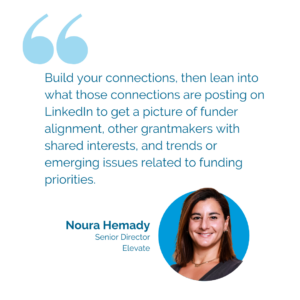 Funder websites are filtered through communications strategies and jargon. As a result, sometimes the highly polished statements of funding priorities and goals found on these official sites are a bit vague and hard to discern. To access a less filtered version of the funder’s agenda and objectives, you can see how program officers are talking about their work at the foundation in their own words via their LinkedIn posts and profiles. Taken alongside reposts and likes, this may help you read between the lines and make a better case for alignment (or alternatively, comprehend if you are not aligned).
Funder websites are filtered through communications strategies and jargon. As a result, sometimes the highly polished statements of funding priorities and goals found on these official sites are a bit vague and hard to discern. To access a less filtered version of the funder’s agenda and objectives, you can see how program officers are talking about their work at the foundation in their own words via their LinkedIn posts and profiles. Taken alongside reposts and likes, this may help you read between the lines and make a better case for alignment (or alternatively, comprehend if you are not aligned).
Tip #4: Take notice of funder meetings and webinars
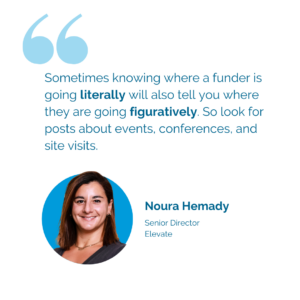 Sometimes knowing where a funder is going literally will also tell you where they are going figuratively. So look for posts about events, conferences, and site visits. These may also inform you about who their grantees are and which organizations they consider to be peers, partners, or otherwise aligned.
Sometimes knowing where a funder is going literally will also tell you where they are going figuratively. So look for posts about events, conferences, and site visits. These may also inform you about who their grantees are and which organizations they consider to be peers, partners, or otherwise aligned.
You also might learn about helpful webinars or virtual events that funders are hosting or attending. For instance, after Noura discovered via LinkedIn that a funder was planning to host a webinar on how to tap into donor-advised funds, her client was able to attend and learn some helpful cultivation tips.
Tip #5: Pay attention to jobs and requests for proposal postings
This is your chance to look into the crystal ball! Before a new portfolio or grantmaking strategy appears on a funder’s website, you might just see hiring posts for new advisors or program officers on LinkedIn first. Similarly, you might get an early glimpse of an RFP or other funding announcements.
For example, Noura noted that a high-profile family foundation posted on LinkedIn about a new program officer position focused on the U.S. South. This position had not yet been posted on the funder’s website. Accordingly, she provided her client with a preview of this new geographic focus.
In another case, a LinkedIn contact Noura was following reposted information about an RFP for expansion into Los Angeles by a new-to-her San Francisco-based funder. She used this information to give her four Los Angeles-based clients a heads up, as each of them had eligible projects. One of these organizations subsequently secured $25,000 in new funding.
So what are you waiting for? Get to sleuthing! It may take some time to build out your Linkedin network in this way, but by following these simple tips, you may reap the dividends!
Also, we’d love to hear from you! Tell us a) if you have any Linkedin fundraising practices that have worked well for you or b) about the results of putting into practice the tips we have suggested here.
Relatedly, please be sure to check out our advice on why you should cultivate relationships with funders. And keep an eye on this space for more tips from Elevate’s fundraising experts!
If you’re a grant seeker, you’ve likely encountered these scenarios.
Scenario 1: You have an existing, positive relationship with a funder. You’ve submitted a proposal for an expanded or new initiative you thought would interest them, but you received a polite decline.
Scenario 2: You identified a perfect new funding prospect. You submitted an inaugural proposal after receiving the greenlight on an LOI, but ultimately the funder did not make an award.
We’ve all been there.
No one relishes hearing the word NO in response to a funding request. While sources vary, an estimated 80% of grant proposals are declined, so any grantseeker is bound to experience their share of rejections. But when you consider – as in all things in life! – that timing is everything, a “No” doesn’t have to remain a “No” for all time. It might help to think of “No” as “Not right now.”
To that end, the team at Elevate pulled together a few of our tried-and-true tips to help you convert a funder NO into a future YES.
1. Open yourself to feedback.
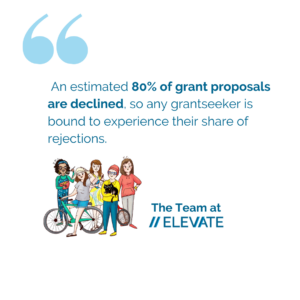 There are many factors that go into funding decisions, both subjective and objective. While you believe in your mission and your organization does excellent work, don’t let that stand in the way of seeing how you can get another bite at the apple. Treat the declination as a valuable learning experience.
There are many factors that go into funding decisions, both subjective and objective. While you believe in your mission and your organization does excellent work, don’t let that stand in the way of seeing how you can get another bite at the apple. Treat the declination as a valuable learning experience.
In addition to graciously thanking the funder for their consideration, invest the time in asking what you could do differently to increase your chances of securing the grant in the next cycle.
If a funder shares any questions or concerns that arose from the proposal, use these inputs to help you shore up those elements for the next grant cycle, make your proposal more compelling, or strengthen an appeal to a different funder who may be interested in your project.
Additionally, in the case of funders that you have not been able to cultivate prior to a request, your first grant proposal might simply be your opportunity to introduce yourself. Consider that even if a proposal was declined, if it opened the door for you to develop a relationship with a new funder, it was by no means a waste of time or effort. Use any communication as an opportunity to reiterate your alignment with the funder’s interests and ask for feedback and an opportunity to apply again in the future.
2. Request a follow-up conversation.
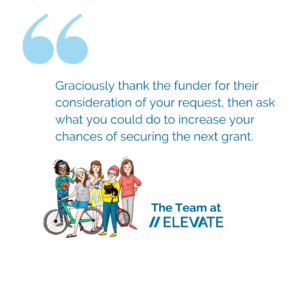 Not all program officers have the time or capacity to hold follow-up conversations about a declined proposal, but many do! Unless they explicitly state otherwise, you should absolutely take the opportunity to request feedback from the funder about your proposal. Request a phone call or meeting, and ask them how you may position yourself to be a more competitive applicant next time around. You can also gauge their interest in other facets of your programming in case something your organization does interests them more than what you originally proposed.
Not all program officers have the time or capacity to hold follow-up conversations about a declined proposal, but many do! Unless they explicitly state otherwise, you should absolutely take the opportunity to request feedback from the funder about your proposal. Request a phone call or meeting, and ask them how you may position yourself to be a more competitive applicant next time around. You can also gauge their interest in other facets of your programming in case something your organization does interests them more than what you originally proposed.
A meeting with a foundation program officer or Board member is a chance to get some behind-the-scenes information. For example, one Elevate team’s client was ostensibly within the funder’s geographic footprint based on eligibility criteria. However, upon speaking to the program officer, our client learned that the foundation had yet to ramp up their giving in the specific neighborhood where the organization is situated, and that they plan to do so the following year. With this encouraging news, the Elevate team planned to submit another request when the foundation was more likely to award a grant to our client.
Alternatively, if it’s challenging to get a meeting on the books, you could ask the funder via phone or email whether they would encourage your organization to reapply during the next grant cycle. Their response may end up yielding some useful insight about your likelihood of securing funding in the future.
3. Seek opportunities to expand your funder network.
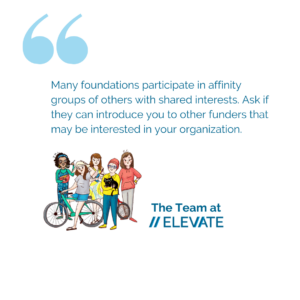 For the most part, foundations operate within a landscape of like-minded organizations, just as nonprofits do. Many funders maintain networks of other philanthropic organizations that share aspects of their giving priorities, and they may even participate in an affinity group of foundations with shared interests. For this reason, after a foundation declines your proposal, it can be valuable to appeal to the funder’s expertise when it comes to other organizations that share their funding priorities. Ask them about other organizations or foundations that they think may be interested in your work, and don’t be afraid to request an introduction to a good point of contact.
For the most part, foundations operate within a landscape of like-minded organizations, just as nonprofits do. Many funders maintain networks of other philanthropic organizations that share aspects of their giving priorities, and they may even participate in an affinity group of foundations with shared interests. For this reason, after a foundation declines your proposal, it can be valuable to appeal to the funder’s expertise when it comes to other organizations that share their funding priorities. Ask them about other organizations or foundations that they think may be interested in your work, and don’t be afraid to request an introduction to a good point of contact.
4. Offer to keep the funder in the loop about your organization.
Fundraising is a long game, so it’s important to be persistent when building a relationship with a grantmaker. As part of your stewardship efforts, you might offer to send periodic updates about your organization’s work or seek to connect with a potential funder through a site visit or a networking event. As a result, they may better understand your work – and your alignment with their interests – the next time you request funding.
5. Refine your prospecting strategy.
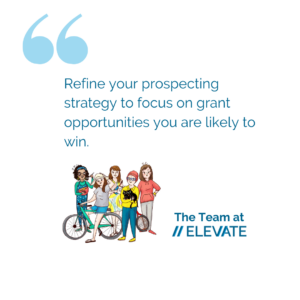 Sometimes, a “No” truly is a “No.” If a program officer makes this explicit, it is not going to do you any good to persist—and may harm your organization’s reputation if you do!
Sometimes, a “No” truly is a “No.” If a program officer makes this explicit, it is not going to do you any good to persist—and may harm your organization’s reputation if you do!
However, this does not mean there isn’t something to learn from the scenario. Reflect on where you misunderstood your organization’s alignment with the funder’s interest, and use this to refine your prospecting strategy so that you can focus on grant opportunities that you are more likely to win.
Consider this example: A nonprofit organization focused on providing services to people who are unhoused submits a grant request to a funder with a broad priority of “housing security”. The request is declined, and after following up to ask for feedback from the program officer, the organization learns that this grantmaker invests in advocacy and systems change organizations rather than those providing direct services. With this information, the nonprofit refines its prospecting strategy to ensure that in the future it pursues grant opportunities with a clear interest in funding direct services.
The bottom line: In order to build a grant program, you are going to hear “No.” But do not despair! Your next steps will make all the difference when it comes to building relationships and refining your grantseeking strategy. And, sometimes you can make bad news work for you!
For more on how to make the most out of a declination, check out this article on Candid. Relatedly, see our blogs on “5 Reasons to Cultivate Relationships with Funders” and “5 Ways to be Pleasantly Persistent with Funder Cultivation.”
Welcome back for a third installment on our Elevate Q&A series, where we “pass the mic” to a member of our extended philanthropic family to examine issues pertinent to the sector and nonprofits! (If you missed our previous conversations, please check out our Q&As with Wade Munday, Bridgestone America’s Director of Corporate Philanthropy; and April Walker, founder of Philanthropy for the People, where we explored some of the challenges and opportunities nonprofits and philanthropists face in pursuing a more equitable approach to their work.)
This time, I spoke with Brian Rosenbaum, the Development Officer for A Place Called Home (APCH), where he holds a portfolio of 150 major and mid-level donors and oversees the organization’s monthly giving program..
For 30 years, A Place Called Home (APCH) has provided South Central Los Angeles youth with a safe, nurturing environment and proven programs in the arts, education, and wellness to help them improve their economic conditions and develop healthy, fulfilling, and purposeful lives. APCH has directly served more than 20,000 youth members through its core school day, after school and summer programming, and over 150,000 local residents through family and supportive services including food, clothing, and holiday toy distributions, counseling, voter education, and community organizing.
Brian is a Southern California native with 18 years of U.S. and international nonprofit experience. He earned his BA in Psychology and Spanish from UCLA and his Masters in Social Work from Columbia University, specializing in program development and community organizing.
My conversation with Brian covered how he leverages his social work training in his current fundraising work, what he sees as the key to successful partnerships with donors, and how he has implemented DEI principles throughout his career.
What It Takes to Successfully Engage Donors
Johnisha Levi: How do you draw upon your background in social work in your current fundraising role?
Brian Rosenbaum: The core values of social work include meeting people where they are, leveraging a strengths-based approach, and capacity building. Each of these is applicable to nonprofit fundraising and communications.
As a nonprofit leader, I also consider ways in which we can hold space for each other to feel seen, to bring our full selves to our work, and to make our best contributions in this world. It’s about discovering ways to pour inspiration into people.
JL: I imagine these values help you to build strong and trusting relationships among colleagues. How would you describe your approach to building relationships with major donors and other partners?
BR: Something that I like to talk about is how “relationship” is sort of a neutral word. You can have a good relationship. You can have a bad relationship. You can have a distant relationship or a close one. On the other hand, a partnership has only one connotation. If you are partners, you are paired.
In a true partnership, everyone gets their needs met, everyone feels heard and seen. And then you grow together and evolve. That’s how I see my role within my staff, with other departments, and with donors; we are partners, and more specifically, we are partners in impact.
When I was at United Way of Greater LA, one of the ways that we described the role of a fundraiser was as a “philanthropic concierge”. It’s all about understanding the impact that a donor wants to make, their priorities, their capacity, their affinity, and their connection to the cause, and then using this information to compose a menu that is in alignment with their passion and interest with our very real funding needs. In implementing this approach, we created meaningful partnerships with donors that led to real impact for our community.
JL: Can you give me an example of your work with a prospective donor that exemplifies this idea of partnering in impact?
 BR: I will share an example of resuscitating a relationship that lapsed prior to my arrival at the Los Angeles Ronald McDonald House. I told my boss, “Challenge accepted.”
BR: I will share an example of resuscitating a relationship that lapsed prior to my arrival at the Los Angeles Ronald McDonald House. I told my boss, “Challenge accepted.”
First, I did a little bit of email outreach to the lapsed donor, and when I didn’t get anything back, I got her on the horn. She was at the grocery store and said she would call back, but she didn’t.
I was tenacious. I got her on the phone again. She shared that she was really disappointed in the lack of appreciation and stewardship. And you know what? Sometimes you just gotta listen. And as a social worker, I embrace any chance I get to listen to people, to really understand what’s going on for them. I told her that I was mortified and angry to hear that she didn’t get the recognition that she deserved. And that she deserved to know the impact of her gift.
I explained how I would do better. I made a list of promises to her, and I delivered on them. Then I brought her in for a tour to see the impact of her gift. At the end of the tour we were sitting down in the dining room having some coffee when she asked about our current needs. I shared a few of our funding priorities, and she said, “Good. Send us a list. You know the things we care about. We’ll see what we can do.”
She and her husband care about safety and security, and comfort and care. So we created a menu with various projects and different price points that were aligned with these interests.
I talked with her several months later. It took some time. But at that point, we settled on a project that satisfied both of our needs – at their previous giving level – and we transformed the broken relationship into a partnership.
Most Important Piece of Advice for a New Fundraiser
JL: You’re clearly a seasoned cultivator and partnership-builder. What advice would you give to a new fundraiser about how to approach donor cultivation?
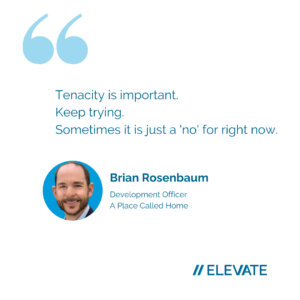 BR: I would say, lean into curiosity, be a sponge. Whether you are stewarding or cultivating donors, know those lists of questions to ask donors from a place of authenticity.
BR: I would say, lean into curiosity, be a sponge. Whether you are stewarding or cultivating donors, know those lists of questions to ask donors from a place of authenticity.
One of my favorite questions to ask that people don’t expect is, “How did you become generous?”
It is also crucial to have genuine curiosity about how a donor would like to be engaged. For example, asking, “Can we schedule some time in two weeks to reconnect to see what you thought about this idea?” Or offering, “Can I send you a quarterly update, because you’re part of our impact?” People rarely say no to this last one.
Tenacity is also important: keep trying. We have to respect donors’ wishes but sometimes it is just a ‘no’ for right now.
The Importance of Applying a DEI Lens
JL: Nonprofits and philanthropists are increasingly focused on ensuring that diversity, equity, and inclusion is the lens through which they implement social change. Can you share a little about your own journey with DEI over the course of your career? What are some of the key lessons you’ve learned?
BR: Graduate school really helped me recognize the power and privilege that I bring into rooms and the fact that every white person is on their own journey of unlearning their racism. Biases are in the air that we breathe. You’ve got some sexism in you. You’ve got some heterosexism in you. You’ve got some ableism in you. You’ve got some nativism in you.
It’s like the moving walkway at the airport; you’re just going to be carried to the end unless you start walking the other way. But it takes a lot of self-work.
I committed myself to doing that work when I came back to LA after grad school, starting with getting involved in AWARE-LA (Alliance of White Anti-Racists Everywhere-Los Angeles). They hold both white-only spaces and multi-racial coalition building spaces with the aim of holding each other accountable and in recognition of the fact that people of color should not have to teach white folks about our own racism.
Subsequent to that, and surrounding the events of 2020 following George Floyd’s murder, I was part of an organization that really took advantage of the opportunity to unpack its past. It opened up a giant, very important conversation about some historical trauma that had happened in the organization and that was still affecting staff.
Out of this process came a renewed sense of responsibility, accountability, and personal growth; you don’t get that opportunity very often.
JL: How do you bring these values that have shaped your own thinking about DEI into your partnership building and donor engagement work?
 BR: I am passionate about ethical storytelling. This means presenting our clients as the heroes of their own story, not people who are broken and need to be fixed. We might be experts on suicide prevention, or food insecurity, or homelessness, but the client is the teacher: they are the experts on their experiences, and should be positioned as such. Sometimes I explain this as seeing the two sides of the coin when it comes to a person. Everyone has both strengths and struggles.
BR: I am passionate about ethical storytelling. This means presenting our clients as the heroes of their own story, not people who are broken and need to be fixed. We might be experts on suicide prevention, or food insecurity, or homelessness, but the client is the teacher: they are the experts on their experiences, and should be positioned as such. Sometimes I explain this as seeing the two sides of the coin when it comes to a person. Everyone has both strengths and struggles.
Ethical storytelling is about finding the balance – truthfully representing stories and situations so that we are educating our audiences about the issues that people are facing, while also including the nuances, the complexities, all of the realities of the situation.
Every time we don’t use an ethical storytelling lens, we do damage by reinforcing negative stereotypes. Imagine the negative impact on a client who actually reads that story in the newsletter or in the annual report or on social media!
With that client in mind, I aim to apply a frame of ethical storytelling in my work as a fundraiser.
JL: That is sage advice! What are a few best practices when it comes to ethical storytelling that you employ?
BR: I have the site www.ethicalstorytelling.com bookmarked and use it all the time. For instance, there is a great media consent form that we utilize. It offers individuals the power to consent to share their story or their likeness in a way that is comfortable for them.
It is also important to make determinations about how to use client images and video in a way that is complementary and uplifting, as well as to include clients in the editing process, and to allow them to approve content.
Interested in learning more about ethical storytelling principles? Sign up for our August 2024 webinar, Introducing and Empowerment Framework for Grant Writing, and look for more resources coming your way on this blog!
These are some common responses from Executive Directors when asked to cultivate a new foundation partner as part of their organization’s larger grant strategy.
Cultivation is often deprioritized in order to “get proposals out the door,” but organizations that ignore the opportunity to build relationships with funding partners before making an ask are doing themselves a huge disservice. If you are looking for some talking points to convince an Executive Director to take action – or perhaps you need some motivation yourself – check out these five tips.
1. Building name recognition with the funder will help you stand out
 When was the last time that you picked up a phone call from “Unknown Caller”? I’m not sure either. When you submit an application to a funder with whom you have never previously spoken, you are essentially that unknown caller in a giant virtual pile of grant applications.
When was the last time that you picked up a phone call from “Unknown Caller”? I’m not sure either. When you submit an application to a funder with whom you have never previously spoken, you are essentially that unknown caller in a giant virtual pile of grant applications.
Need proof? Elevate clients have received responses to cold submissions like this one from the Robert Wood Johnson Foundation:
“We received 342 proposals and can support only 3-4 projects…”
And this one from the Aetna Foundation:
“ We received close to 1,800 applications from locations across the contiguous United States…”
Instead of resigning yourself to being one of hundreds of virtually anonymous applicants in a stack, cultivation activities give you an opportunity to develop name recognition and – maybe – build excitement with the Program Officer about your work.
Bottom line: Cultivation gives you an advantage over the unknown organizations in the pile, and it increases the likelihood that your proposal will receive serious consideration.
2. Getting clarification early could avoid a huge waste of staff time later
Philanthropy is not immune to a culture of buzzwords – innovation, strategy, moving the needle, etc. Your definition of “innovative” or “strategy” could differ greatly from the funder’s. Speaking with a Program Officer before you spend a great deal of time and effort on a complex proposal could save you the trouble of learning later that your program is not quite innovative enough.
Alternatively, it may present you with the opportunity to convince the Program Officer otherwise. You can prevent your proposal from being tossed aside during a high level review if you have clarified definitions and expectations in advance.
Bottom line: Cultivation could save the organization time and money.
3. Insider information is not shared with the outsiders
 Yes, the funder’s website or RFP will outline the official funding priorities, application guidelines, and deadlines. Do you know what it won’t share? You won’t read about the not-yet-official funding priorities that may be incredibly well-aligned with your program and that may even offer a much larger funding amount. The website also won’t recommend that you apply in this current grant cycle because the next one is much more competitive for a smaller pot of money.
Yes, the funder’s website or RFP will outline the official funding priorities, application guidelines, and deadlines. Do you know what it won’t share? You won’t read about the not-yet-official funding priorities that may be incredibly well-aligned with your program and that may even offer a much larger funding amount. The website also won’t recommend that you apply in this current grant cycle because the next one is much more competitive for a smaller pot of money.
A conversation with a human – via email, phone, or Zoom – is much more likely to give you information that has not yet been made public (or may never be) .
Bottom line: Cultivation gives you access to information that others do not have.
4. Even if a funder isn’t interested, they may know someone who is
Funders network too. Program Officers are aware of who else is granting money to organizations in their issue area and geographical community. Groups such as the Philanthropy Network Greater Philadelphia, Philanthropy DMV, and other regional funder networks and issue-based affinity groups regularly bring together foundations with similar goals.
When you speak with a Program Officer on the phone, it is absolutely possible that they make recommendations for where else you might pursue funding. And you don’t have to wait for them to offer – why not ask, “Do you know of any other foundations who may be interested in supporting this project?” Heck, they may even be willing to make an introduction for you!
Bottom line: Cultivation multiplies new relationships (and new funding opportunities).
5. Even rigorous review processes have some measure of subjectivity
 At least as far as we are aware, foundations do not feed their grant proposals into an AI system to review and make funding decisions. Review Committees are made up of humans, and these humans decide which applicants will receive their much coveted dollars.
At least as far as we are aware, foundations do not feed their grant proposals into an AI system to review and make funding decisions. Review Committees are made up of humans, and these humans decide which applicants will receive their much coveted dollars.
Cultivation connects your organization’s people to the Foundation’s people in a way that can not be achieved through words on a screen.
Bottom line: Cultivation is the not-so-secret way to humanize your work for the humans making decisions.
Ready to get started? Check out this blog post with tips on how to keep in touch and build meaningful relationships with your funding partners.
We are back with the second in a series of blogs where we “pass the mic” to another member of the multifaceted philanthropic community to gain their personal perspective on issues relevant to the sector and nonprofits. (If you missed our first Q&A, be sure to check out our earlier discussion with Philanthropy for the People’s April Walker.)
This time, I sat down with a fellow Nashvillean, Wade Munday. In January 2023, Wade assumed the role of Bridgestone Americas’ first Director of Corporate Philanthropy and Social Impact, where he is responsible for advancing and directing the strategy and execution of the company’s philanthropic and social programs. He manages the operations of Bridgestone Americas Trust Fund, corporate philanthropy, and workplace giving.
Wade has 15 years of experience working with nonprofits, corporate trusts and government-affiliated organizations. His career in the nonprofit sector began at Children’s Hospital Boston. He was the founding executive director of two smaller nonprofits and the Co-Director of the Addis Clinic, a nonprofit focused on extending access to healthcare in communities throughout Africa. Wade is a graduate of Vanderbilt Divinity School, where he studied under such luminaries as civil rights icon Reverend James Lawson. He credits his time at Vanderbilt with helping to shape his strong social justice orientation.
My conversation below with Wade includes an exploration of his current corporate philanthropy role, guidance for nonprofits seeking institutional funding, and how he has centered Diversity Equity & Inclusion principles in his own work.
Leveraging Bridgestone’s Expertise in Creating Social Impact
Johnisha Levi: Can you share with us a bit about the lead up to creating this new Corporate Philanthropy and Social Impact role at Bridgestone? Before you came, what was the structure for making decisions and awarding support?
 Wade Munday: In the 1980s, Bridgestone, the largest rubber manufacturer in the world, acquired Firestone, along with all of the companies associated with it. And within those companies was a trust fund that was seeded initially with a $1.5 million endowment. The trust fund was originally established to benefit the Akron, Ohio community. With Bridgestone, this was extended to supporting communities around the country. With this change, the decision-making became very diffuse and guided by team members’ and executives’ interests.
Wade Munday: In the 1980s, Bridgestone, the largest rubber manufacturer in the world, acquired Firestone, along with all of the companies associated with it. And within those companies was a trust fund that was seeded initially with a $1.5 million endowment. The trust fund was originally established to benefit the Akron, Ohio community. With Bridgestone, this was extended to supporting communities around the country. With this change, the decision-making became very diffuse and guided by team members’ and executives’ interests.
We were and still remain the largest contributor to the United Way of Greater Nashville. That relationship goes back 30 years, because our CEO at the time was very invested in social services and strengthening the social safety net of Nashville. We have also prioritized investing in athletes with different abilities through Adaptive Sports Ohio because it aligns with our sports partnerships (Bridgetone sponsors both the Olympics and the Paralympics). We have given money to many other nonprofit organizations, but it is fair to say our reach was broad, not deep.
JL: What are your current priorities in your new role?
WM: Going forward, Bridgestone is looking to co-create impact and co-create value with partners in the nonprofit sector that we work with, and deepen those relationships. Through alignment of our business interests and our giving priorities, we will apply Bridgestone’s company ethos— to serve society with quality products, services, and solutions in the mobility space—to the work of creating meaningful change in society.
Specifically, Bridgestone is especially interested in increasing the number of women in the auto tech workforce, which right now is abysmally low. We see supporting organizations such as Play Like a Girl and TechForce Foundation as a means of narrowing this gap.
We’ve started partnership discussions with Play Like A Girl, which in the last twenty years has encouraged girls to be more involved in team sports as a means to engage them in STEM activities and prepare for executive careers, including at corporations such as Bridgestone. This is an organization that focuses on not only young girls, confidence, and mental health, but also diversity in team sports, the classroom, and C-Suite offices throughout the country. We’ll be working with them to enroll girls in Nashville and the Cleveland area (where we have another corporate presence) in mentorship circles with Bridgestone teammates. Likewise, Bridgestone is working with TechForce Foundation, a nonprofit committed to the career exploration and workforce development of professional technicians, on closing the gender gap in the autotech workforce.
Lessons from–and Advice for—the Nonprofit Sector
JL: Tell us about your background in healthy equity and nonprofits and some of the strengths and insights that you feel you bring to the world of corporate philanthropy? How do you think your experiences shaped your conceptions of philanthropy?
WM: I think philanthropy is extremely limited in its ability to address our healthcare system. However, it can be a catalyst for what I think most solutions to our greatest social problems are, which is greater government involvement. Big government, when effective, can achieve significant impact. My own family history is an example of this; when the federal government intervened to bring electricity to the Tennessee Valley, many people were lifted out of poverty.
I think inasmuch as corporate philanthropy can be involved and build relationships with organizations that are engaged in health equity, they can and should also support advocacy work and not shy away from what the actual solutions are, which is that we can’t keep making this piecemeal approach that is doing nothing to really cut costs on our public systems or for individuals. Ultimately we need to find a government solution that is going to be fair and equitable to everyone involved.
JL: What is a piece of advice you can give to nonprofits seeking institutional funding from a corporate partner like Bridgestone ?
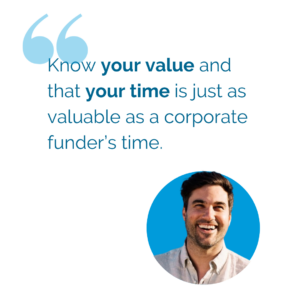 WM: Know your value and that your time is just as valuable as a corporate funder’s time, and it’s not worth trying to change your program to fit the corporate interests, because we do have a corporate interest. We do want to move our business forward, and if that is going to hinder your work as a nonprofit, if that’s going to drain your time as a leader in a nonprofit, then don’t do it. It will be much better to find another partner.
WM: Know your value and that your time is just as valuable as a corporate funder’s time, and it’s not worth trying to change your program to fit the corporate interests, because we do have a corporate interest. We do want to move our business forward, and if that is going to hinder your work as a nonprofit, if that’s going to drain your time as a leader in a nonprofit, then don’t do it. It will be much better to find another partner.
I think as a fundraiser you often look at the field of foundations and you look at their assets, and you think, “ohh this organization has X amount of money, they can definitely spare some money for us.”
But with corporate giving, and many foundations, funding determinations are often driven by answers to questions like, “Where are we contextually relevant? Where do we have expertise and experience?” For instance at Bridgestone, we have scientists and researchers. We have an environment and health department. We’ve got a legal department, and so all these areas where we have valuable experience should be leveraged to further our grantmaking. We’re not just giving money, but we’re also leveraging our talent and skills to go that much further, which means that we can’t give to everyone, but instead we give in a way that is going to leverage our resources. And I think that’s going to make for a better relationship with our nonprofit partners.
Implementing Diversity, Equity, and Inclusion Initiatives
JL: What has centering DEI in your career looked like?
WM: At The Addis Clinic, we worked with state departments and other organizations to deliver telemedicine services in underserved areas in East Africa, refugee camps, and other areas where primary care was not readily available. I was a white male providing direct services to refugee communities. While I recognized that my white privilege conferred certain advantages when it came to fundraising and other aspects of the executive director role, I felt the responsibility to create opportunities for others to lead. As a result, I worked to create a succession plan so that I would be co-director alongside a female healthcare provider.
Prior to the Addis Clinic, I was at Tennessee Justice for Our Neighbors, which provided legal assistance to people seeking asylum and other humanitarian forms of legal relief, and supported victims of violent crimes who needed mental health services and trauma counseling. There, we observed a gross inequity in the number of people of color who were judges and lawyers. In response, we created a six-week summer program to give young BIPOC college students access to judges and lawyers as mentors. We admitted students to the summer program by taking the inverse of what law school currently looks like, which is approximately 3% Latino, 10% African American, and 30% women. It was a refreshing way of looking at entrenched systems of society. I would like to see that in more areas of my work going forward.
Now at Bridgestone Americas, I inherited the current committee that manages the trust fund. Fortunately our leaders were really thoughtful about the composition of the committee, but I think there’s still some work to do in terms of diversity. We want to articulate our commitment to diversity, equity, and inclusion through a simple statement of our values and principles. We want to encourage participation from the next generation of leaders at the company, include more voices from underrepresented groups within the company, and be champions for our employee resource groups. We are democratizing grantmaking within the company through employee matching gifts and empowering employee resource groups to provide unrestricted operating grants to nonprofits.
You can learn more about the Bridgestone Americas Trust Fund here. If you found this conversation thought-provoking, keep your eye on this space for new Elevate Q&As in the coming months.
At Elevate, we’ve been thinking a lot this year about Artificial Intelligence (AI) and how it could influence the way that we perform our work supporting nonprofits in building more sustainable grants programs. AI is increasingly relevant in everyday business operations across numerous industries, and it has been applied for many years in ways that many people don’t realize – mapping apps like Google Maps, voice assistants like Alexa and Siri, even the autocorrect feature in your texting app or word processing software are powered by artificial intelligence.
Some interesting trends have emerged in 2023, which hint at AI’s potential while also raising significant ethical and information security considerations. A recent Forbes Advisor survey reports that:
- ChatGPT, an AI powered large language model, had 1 million users within the first five days of being available.
- 54% of survey respondents believe that AI tools like ChatGPT can improve written content by enhancing text quality, creativity, and efficiency in various content creation contexts.
- AI is expected to see an annual growth rate of 37.3% between now and 2030.
- The majority of consumers are concerned about business use of AI.
Accordingly, Elevate is treading optimistically – yet cautiously – when it comes to AI! While we are exploring how AI can create efficiencies in our work, we are also committed to maintaining the highest quality and privacy standards for our clients.
I recently spoke with a handful of my most forward-thinking and tech-savvy Elevate colleagues, who offered their thoughts on what AI applications are and aren’t helpful in aspects of their work advising nonprofit clients. We share their insights here for your consideration as we all navigate this brave new world.
Because many of the questions Elevate receives about AI are about ChatGPT specifically, we begin with the 411 on this tool.
Even if you haven’t yet used it yourself, you’ve undoubtedly heard the buzz about ChatGPT. ChatGPT is a free, natural language processing tool that can answer questions and support users with tasks such as composing emails, essays, and code. It can spew out responses in a matter of seconds. It does this by analyzing your question or prompt, then – using the dataset it was trained on – predicting the next word or series of words based on what you’ve entered.
But is it savvy enough to write sophisticated, nuanced, and winning grants?
Our colleagues were unequivocal in their response: Not even close.
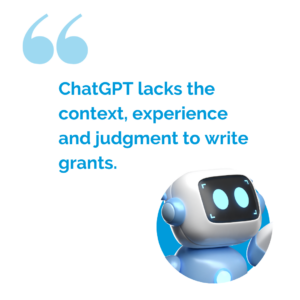 This is because ChatGPT lacks the context, experience and judgment to handle such complex work. Even when I asked ChatGPT “What are the Pros and Cons of Using ChatGPT for grant writing?” it didn’t disagree! While ChatGPT praised its speed and ability to maintain consistency in “tone, language, and messaging” across various sections of a grant proposal and to polish language, it cautioned that it may not fully appreciate the “nuances” of grant guidelines, that it has limitations in understanding the context of an organization’s work and history, and that it could also produce plagiarizing text.
This is because ChatGPT lacks the context, experience and judgment to handle such complex work. Even when I asked ChatGPT “What are the Pros and Cons of Using ChatGPT for grant writing?” it didn’t disagree! While ChatGPT praised its speed and ability to maintain consistency in “tone, language, and messaging” across various sections of a grant proposal and to polish language, it cautioned that it may not fully appreciate the “nuances” of grant guidelines, that it has limitations in understanding the context of an organization’s work and history, and that it could also produce plagiarizing text.
The text that ChatGPT generates in response to a question or prompt might not even be factual – there are absolutely no assurances that the information is accurate or true.
What’s more, because ChatGPT and other AI models draw upon existing content, AI can reflect underlying societal biases, perpetuating stereotypes and white supremacist notions. At Elevate, we know that historically marginalized communities are not “vulnerable” objects of charity, but agents and partners of the social change that they desire to see. This level of social context is far too complex for an AI-powered language model to appropriately reflect.
So, what are the appropriate uses of ChatGPT?
If you do want to experiment with ChatGPT in your writing tasks, we suggest using it for simpler, less analytical tasks, such as condensing word count, identifying alternative phrasing to avoid repetition, or summarizing the main points of your research into more readable language.
ChatGPT also has the potential to provide administrative support for your work, and can be harnessed to:
- Organize a to-do list
- Summarize meeting minutes
- Brainstorm ideas
But whatever you do, do NOT rely on ChatGPT to produce your next grant proposal.
 I know what you are thinking: It’s no surprise that a grant writing firm is telling me not to use an AI tool to write grants! But we are not just saying this because we want to be your grant writers. (Though we DO want to be your grant writers!)
I know what you are thinking: It’s no surprise that a grant writing firm is telling me not to use an AI tool to write grants! But we are not just saying this because we want to be your grant writers. (Though we DO want to be your grant writers!)
At Elevate, we firmly believe that good grant writing is a thoughtful, strategic exercise that requires skill, nuance, and informed decision making. ChatGPT – like other AI tools – is neither thoughtful nor strategic. It lacks discernment of nuance, and is incapable of making reasoned choices about how to present an organization’s work to a funding partner.
Simply producing large volumes of content – that may or may not be factual! – is NOT the point of grant writing. And this is truly all that ChatGPT is doing: generating text.
AI Tools CAN Help You Take Notes, Summarize Content, and Find Information
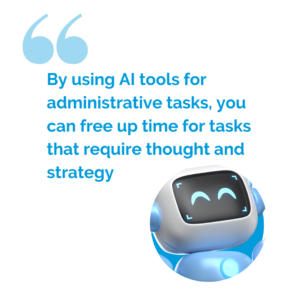 At Elevate, some of our staff are experimenting with the use of AI-powered tools such as Simon Says AI and Fathom Notetaker to capture meeting notes and provide summaries of important conversations that they need to refer back to later or share with colleagues who couldn’t attend meetings. By using AI tools for more administrative tasks, you can free up some of your own time and energy for tasks that require thought and strategy – something AI can’t do!
At Elevate, some of our staff are experimenting with the use of AI-powered tools such as Simon Says AI and Fathom Notetaker to capture meeting notes and provide summaries of important conversations that they need to refer back to later or share with colleagues who couldn’t attend meetings. By using AI tools for more administrative tasks, you can free up some of your own time and energy for tasks that require thought and strategy – something AI can’t do!
As a tool developed by Google, Bard can interface with Google Workspace tools, if you choose to connect these. This means, you can ask Bard to find dates, taks, or other information in gmail, or to summarize a report a colleague shared via Google docs.
Interested in exploring more options for what you can do with AI tools? Check out FutureTools.io, which aggregates AI tools suited for different purposes.
Please Please Please: Inform yourself about privacy!
If you take only one thing away from this article, I hope it is this: get informed about the privacy of the information you share with AI tools, and take precautions to protect your information.
When using any cloud-based technology platform, it is imperative that consideration be given to the way these tools use, store, and share information. Depending on your privacy settings, information you share with tools like Bard and ChatGPT may be used to improve its own language model. This means your data may not only be available to its creators (OpenAI), but also to others who use the platform.
For instance, when first accessing Bard, users are notified that Google will collect conversations and other information like the user’s location, store this data for a period of time, and use it to refine the tool. Furthermore, users are informed that “human reviewers read, annotate, and process your Bard conversations,” and they are warned to not share confidential information.
 For these reasons, think carefully about what information you share with AI tools. Remember that a grant application may include information about your organization, programs, staff, and future plans that might be considered private. A good rule of thumb is, if you wouldn’t want a piece of data or information on your public website for anyone to find, you should not share that information with an AI tool.
For these reasons, think carefully about what information you share with AI tools. Remember that a grant application may include information about your organization, programs, staff, and future plans that might be considered private. A good rule of thumb is, if you wouldn’t want a piece of data or information on your public website for anyone to find, you should not share that information with an AI tool.
How is your organization using AI powered tools, and what have you found useful, scary, hopeful, or exciting about these tools? We invite you to share!
Are you still feeling overwhelmed, or do you want to learn more? Here are a few sources the team at Elevate is using to stay informed:







 Planning doesn’t need to be perfect. It just needs to start.
Planning doesn’t need to be perfect. It just needs to start. You don’t need to have all the answers. But you
You don’t need to have all the answers. But you  At Elevate, leveraging a mix of paid and free prospect research tools ensures high-quality outcomes for clients. Here’s a breakdown of some key tools and how they can elevate your grant-seeking efforts:
At Elevate, leveraging a mix of paid and free prospect research tools ensures high-quality outcomes for clients. Here’s a breakdown of some key tools and how they can elevate your grant-seeking efforts: 3. Inside Philanthropy
3. Inside Philanthropy First, there is far more public funding than private funding.
First, there is far more public funding than private funding.  First, talk with your funding partners. Foundations and corporations rely on their grantees to tell them about community needs – it’s why nearly every grant proposal requires you to
First, talk with your funding partners. Foundations and corporations rely on their grantees to tell them about community needs – it’s why nearly every grant proposal requires you to  Keep in mind that the
Keep in mind that the  The efforts to dismantle DEI in philanthropic and nonprofit sectors predates the recent Executive Orders. Our colleague, Johnisha Levi, published
The efforts to dismantle DEI in philanthropic and nonprofit sectors predates the recent Executive Orders. Our colleague, Johnisha Levi, published  Considering a future where you have fewer resources and are thus less able to do this important work can be overwhelming.
Considering a future where you have fewer resources and are thus less able to do this important work can be overwhelming.  Through the new GAP Suite, we’re excited to offer a menu of project-based engagements that are cost efficient, maintain a laser focus on a specific component of an effective grants program, and are modular in order to build on each other in the way that makes the most sense for each organization. Each project within the GAP Suite is a four- or six-week collaboration designed to address a specific strategic fundraising need or question. While we have a standard sequence that many organizations will fit into, we can build out a series of engagements that best fits your needs and resources on a timeline that works for you.
Through the new GAP Suite, we’re excited to offer a menu of project-based engagements that are cost efficient, maintain a laser focus on a specific component of an effective grants program, and are modular in order to build on each other in the way that makes the most sense for each organization. Each project within the GAP Suite is a four- or six-week collaboration designed to address a specific strategic fundraising need or question. While we have a standard sequence that many organizations will fit into, we can build out a series of engagements that best fits your needs and resources on a timeline that works for you.  Once you have built out your connections, lean into what those connections are posting. This includes likes and reposts by program officers and foundation leadership. From there, you can begin to get a clearer picture of foundation alignment—who do they consider to be a
Once you have built out your connections, lean into what those connections are posting. This includes likes and reposts by program officers and foundation leadership. From there, you can begin to get a clearer picture of foundation alignment—who do they consider to be a  Funder websites are filtered through communications strategies and jargon. As a result, sometimes the highly polished statements of funding priorities and goals found on these official sites are a bit vague and hard to discern. To access a less filtered version of the funder’s agenda and objectives, you can see how program officers are talking about their work at the foundation in their own words via their LinkedIn posts and profiles. Taken alongside reposts and likes, this may help you read between the lines and make a better case for alignment (or alternatively, comprehend if you are not aligned).
Funder websites are filtered through communications strategies and jargon. As a result, sometimes the highly polished statements of funding priorities and goals found on these official sites are a bit vague and hard to discern. To access a less filtered version of the funder’s agenda and objectives, you can see how program officers are talking about their work at the foundation in their own words via their LinkedIn posts and profiles. Taken alongside reposts and likes, this may help you read between the lines and make a better case for alignment (or alternatively, comprehend if you are not aligned). Sometimes knowing where a funder is going
Sometimes knowing where a funder is going  There are many factors that go into funding decisions, both subjective and objective. While you believe in your mission and your organization does excellent work, don’t let that stand in the way of seeing how you can get another bite at the apple. Treat the declination as a valuable learning experience.
There are many factors that go into funding decisions, both subjective and objective. While you believe in your mission and your organization does excellent work, don’t let that stand in the way of seeing how you can get another bite at the apple. Treat the declination as a valuable learning experience.  Not all program officers have the time or capacity to hold follow-up conversations about a declined proposal, but many do! Unless they explicitly state otherwise, you should absolutely take the opportunity to request feedback from the funder about your proposal. Request a phone call or meeting, and ask them how you may position yourself to be a more competitive applicant next time around. You can also gauge their interest in other facets of your programming in case something your organization does interests them more than what you originally proposed.
Not all program officers have the time or capacity to hold follow-up conversations about a declined proposal, but many do! Unless they explicitly state otherwise, you should absolutely take the opportunity to request feedback from the funder about your proposal. Request a phone call or meeting, and ask them how you may position yourself to be a more competitive applicant next time around. You can also gauge their interest in other facets of your programming in case something your organization does interests them more than what you originally proposed.  For the most part, foundations operate within a landscape of like-minded organizations, just as nonprofits do. Many funders maintain networks of other philanthropic organizations that share aspects of their giving priorities, and they may even participate in an
For the most part, foundations operate within a landscape of like-minded organizations, just as nonprofits do. Many funders maintain networks of other philanthropic organizations that share aspects of their giving priorities, and they may even participate in an  Sometimes, a “No” truly is a “No.” If a program officer makes this explicit, it is not going to do you any good to persist—and may harm your organization’s reputation if you do!
Sometimes, a “No” truly is a “No.” If a program officer makes this explicit, it is not going to do you any good to persist—and may harm your organization’s reputation if you do! BR: I will share an example of resuscitating a relationship that lapsed prior to my arrival at the Los Angeles Ronald McDonald House. I told my boss, “Challenge accepted.”
BR: I will share an example of resuscitating a relationship that lapsed prior to my arrival at the Los Angeles Ronald McDonald House. I told my boss, “Challenge accepted.”  BR:
BR:  BR:
BR: When was the last time that you picked up a phone call from “Unknown Caller”?
When was the last time that you picked up a phone call from “Unknown Caller”? Yes, the funder’s website or RFP will outline the official funding priorities, application guidelines, and deadlines. Do you know what it won’t share? You won’t read about the not-yet-official funding priorities that may be incredibly well-aligned with your program and that may even offer a much larger funding amount. The website also won’t recommend that you apply in this current grant cycle because the next one is much more competitive for a smaller pot of money.
Yes, the funder’s website or RFP will outline the official funding priorities, application guidelines, and deadlines. Do you know what it won’t share? You won’t read about the not-yet-official funding priorities that may be incredibly well-aligned with your program and that may even offer a much larger funding amount. The website also won’t recommend that you apply in this current grant cycle because the next one is much more competitive for a smaller pot of money.  At least as far as we are aware, foundations do not feed their grant proposals into an AI system to review and make funding decisions. Review Committees are made up of humans, and these humans decide which applicants will receive their much coveted dollars.
At least as far as we are aware, foundations do not feed their grant proposals into an AI system to review and make funding decisions. Review Committees are made up of humans, and these humans decide which applicants will receive their much coveted dollars. Wade Munday:
Wade Munday: WM:
WM:  This is because ChatGPT lacks the context, experience and judgment to handle such complex work. Even when I asked ChatGPT “What are the Pros and Cons of Using ChatGPT for grant writing?” it didn’t disagree! While ChatGPT praised its speed and ability to maintain consistency in “tone, language, and messaging” across various sections of a grant proposal and to polish language, it cautioned that it may not fully appreciate the “nuances” of grant guidelines, that it has limitations in understanding the context of an organization’s work and history, and that it could also produce plagiarizing text.
This is because ChatGPT lacks the context, experience and judgment to handle such complex work. Even when I asked ChatGPT “What are the Pros and Cons of Using ChatGPT for grant writing?” it didn’t disagree! While ChatGPT praised its speed and ability to maintain consistency in “tone, language, and messaging” across various sections of a grant proposal and to polish language, it cautioned that it may not fully appreciate the “nuances” of grant guidelines, that it has limitations in understanding the context of an organization’s work and history, and that it could also produce plagiarizing text.  I know what you are thinking: It’s no surprise that a grant writing firm is telling me not to use an AI tool to write grants! But we are not just saying this because we want to be your grant writers. (Though we DO want to be your grant writers!)
I know what you are thinking: It’s no surprise that a grant writing firm is telling me not to use an AI tool to write grants! But we are not just saying this because we want to be your grant writers. (Though we DO want to be your grant writers!)  At Elevate, some of our staff are experimenting with the use of AI-powered tools such as
At Elevate, some of our staff are experimenting with the use of AI-powered tools such as  For these reasons, think carefully about what information you share with AI tools. Remember that a grant application may include information about your organization, programs, staff, and future plans that might be considered private.
For these reasons, think carefully about what information you share with AI tools. Remember that a grant application may include information about your organization, programs, staff, and future plans that might be considered private.